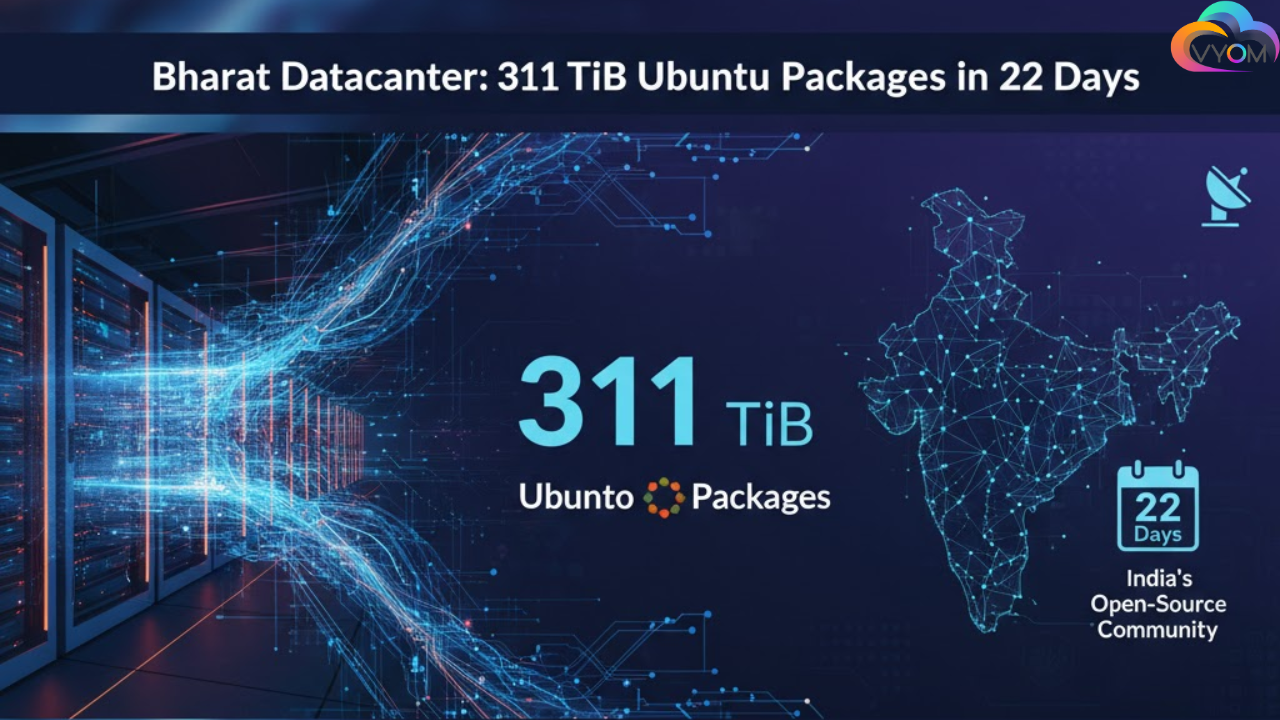How Bharat Datacenter Delivered 311 TiB of Ubuntu Packages in 22 Days for India’s Open-Source Community
India’s digital backbone grows stronger every year, and the country’s tech ecosystem now relies on infrastructure that can keep up with real-world demand. Developers, enterprises, startup engineering teams, DevOps pipelines, and even home users depend on fast operating system updates and package installations to keep their systems secure and running smoothly. When a software mirror is slow, it doesn’t just irritate people. It breaks workflows, delays deployments, and brings development pipelines to a halt.
To help fix this, Bharat Datacenter runs a high-speed Ubuntu mirror hosted inside India. It’s built to deliver package updates with minimal latency, no bottlenecks, and consistent reliability across the country. What happened in the last few weeks shows how much difference a well-engineered local mirror can make.
Between 05 October 2025 and 27 October 2025, the Bharat Datacenter Ubuntu mirror delivered a staggering amount of data across India. These weren’t artificial benchmarks or one-off events. This was genuine load from production servers, cloud platforms, home systems, CI/CD pipelines, educational institutions, and public sector machines.
And the numbers speak for themselves.
A Real-World Stress Test: 311.74 TiB Delivered in Just 22 Days
During this 22-day period, the mirror handled:
- 2,51,01,589 total requests
- 2,51,01,583 valid requests
- Only 6 failed requests
- 12,37,477 unique visitors
- 8,38,647 unique requested files
- 311.74 TiB of data transferred
Every one of these hits represents developers installing packages, servers pulling updates, automated scripts provisioning systems, and machines staying secure with timely patches.
Unlike global mirrors, a domestic one doesn’t suffer from routing delays or unpredictable hops. Everything stays within India’s network ecosystem, which makes a noticeable difference in speed and reliability.
What happened over these 22 days is more than a technical milestone. It’s a clear example of how Indian infrastructure has matured and how much value a local mirror adds to the developer community.
Why This Matters for India’s Tech Ecosystem
1. Faster Package Delivery for Daily Development Work
Whether someone is installing dependencies for a new project or patching hundreds of servers at once, speed matters. Slow downloads eat time and break automation pipelines.
A local mirror dramatically improves:
- apt install performance
- security update fetch times
- CI/CD pipeline workflows
- auto-deployment scripts
- cloud-init provisioning speed
The mirror cuts latency so sharply that daily tasks feel smoother across the board. For DevOps teams and cloud engineers, it means more predictable automation and fewer deployment delays.
2. Bandwidth Stays Inside India
One of the most overlooked benefits of a local mirror is how much national bandwidth it saves.
Millions of package downloads that would otherwise travel internationally now stay inside the country. That leads to better:
- routing
- stability
- connectivity speed
- cost efficiency
- digital sovereignty
This matters for tech campuses, government institutions, universities, ISPs, and even growing startups that can’t afford constant dependency on foreign bandwidth routes.
In simple terms, the mirror reduces load on international links and keeps traffic local, which benefits the entire internet ecosystem of the country.
3. Near-Perfect Reliability at Massive Scale
Only six failed requests out of more than 2.5 crore is practically unheard of for a public mirror serving nationwide traffic.
This level of uptime and consistency shows how resilient the Bharat Datacenter backbone is. Ubuntu mirrors around the world often face:
- slowdowns during peak traffic
- packet loss during heavy loads
- routing issues for remote regions
- inconsistencies between ISPs
Here, almost everything went right. The mirror didn’t just survive the traffic. It stayed fast and responsive throughout the entire period.
4. Built for Real-World Open-Source Workloads
The mirror isn’t just a service. It’s a full-scale stress test for infrastructure, and Bharat Datacenter passed it with ease.
Delivering more than 311 TiB of package data in under a month proves that the backbone is designed for heavy workloads. It also confirms that:
- throughput remains stable under high load
- routing is optimized for Indian ISPs
- the network handles long-duration traffic surges
- hardware and architecture are tuned for performance
These are the qualities enterprises look for when deploying bandwidth-intensive applications. The mirror shows that Bharat Datacenter can support environments where large-volume data delivery is normal, not exceptional.
The Network Behind the Performance
This kind of delivery is possible because the infrastructure behind it is built specifically for high-speed traffic inside India. Bharat Datacenter’s network includes:
- low-latency national peering
- high-capacity uplinks
- carrier-neutral connectivity
- optimized routing for Indian ISPs
- redundant power and cooling
- enterprise-grade hardware
A public mirror pushes the network constantly, and that makes it the perfect metric for evaluating performance. Every download, every automated script, every server update becomes a real-world validation of the network.
And during these 22 days, the validation was loud and clear.
Strengthening India’s Open-Source Community
India is home to one of the world’s most rapidly expanding developer communities. Open-source software is a major part of that growth, powering coding education, startups, research institutions, cloud companies, and government systems.
By hosting public mirrors that serve terabytes of traffic every day, Bharat Datacenter is contributing directly to this ecosystem. Faster mirrors support:
- better developer experience
- quicker server provisioning
- stable package updates
- reduced dependency on overseas servers
- healthier nationwide infrastructure
Open-source thrives when infrastructure is accessible, fast, and dependable. This mirror helps make that possible.
Why Organizations Are Paying Attention
The traffic handled by the Ubuntu mirror is a strong indicator of what Bharat Datacenter’s backbone can support. For organizations that need:
- high-performance dedicated servers
- cloud compute optimized for CI/CD
- bandwidth-heavy deployments
- hosting for repositories or artifacts
- private mirrors for internal use
- secure, latency-optimized infrastructure in India
the mirror acts as a real-world reference case. It’s proof that the network can withstand intense demand without compromising performance.
If the same backbone can deliver hundreds of terabytes of Linux packages across the country, it can handle enterprise workloads with ease.
Building on India’s Performance-Optimized Infrastructure
Bharat Datacenter is built in India for Indian businesses, educational institutions, startups, and developers who need fast, dependable, low-latency infrastructure.
The Ubuntu mirror is just one example of what the network can do when pushed hard. Hundreds of thousands of systems pulled updates through it every day, and it held steady from start to finish.
For any organization looking to build on reliable, India-based infrastructure, this performance should be reassuring. It shows what’s possible when the backbone is engineered properly.
If your team needs the same reliability for CI/CD, cloud servers, compute clusters, or bandwidth-heavy deployments, the infrastructure that powered this mirror is ready for you.
Let’s Get Social:
Facebook: https://www.facebook.com/vyomcloudnetwork/
LinkedIn: https://www.linkedin.com/company/vyomcloud/
Instagram: https://www.instagram.com/vyomcloud/
FAQs: Bharat Datacenter Ubuntu Mirror
1. What is the Bharat Datacenter Ubuntu mirror?
It’s a high-speed, India-hosted mirror that delivers Ubuntu updates, packages, and repositories with low latency. Developers, servers, CI/CD pipelines, and institutions across the country use it for faster and more reliable downloads.
2. Why is a local Ubuntu mirror important for India?
A domestic mirror keeps bandwidth inside India, reduces latency, improves routing, and speeds up installs and updates. It also boosts digital independence by reducing reliance on international servers.
3. How much traffic did the mirror handle in 22 days?
Between 05 October 2025 and 27 October 2025, the mirror delivered 311.74 TiB of Ubuntu packages with more than 2.51 crore requests and nearly zero failures.
4. Who benefits the most from this mirror?
Developers, DevOps teams, cloud engineers, universities, government systems, and home users all benefit. Anyone who installs packages or updates Ubuntu regularly sees faster performance.
5. How reliable is the mirror?
Out of over 2.5 crore requests, only six failed. That level of consistency is rare for public mirrors and shows how stable Bharat Datacenter’s infrastructure is.
6. Does the mirror improve CI/CD and automation speed?
Yes. CI/CD pipelines, deployment scripts, and cloud-init provisioning run faster because they can fetch packages without international latency or routing delays.
7. Can enterprises build private mirrors on Bharat Datacenter’s network?
Absolutely. The same backbone that powers this public mirror can support private mirrors, artifact storage, repositories, and bandwidth-heavy enterprise workloads.
8. Is this mirror useful for cloud servers and VPS?
Yes. Cloud servers hosted anywhere in India see lower latency and faster package delivery when using a domestic Ubuntu mirror, which improves overall server performance.
9. How does this mirror support India’s open-source community?
It speeds up development, makes updates more dependable, reduces server downtime, and provides a strong backbone for open-source growth across the country.
10. How can organizations use Bharat Datacenter infrastructure?
Teams that need dedicated servers, cloud compute, or high-bandwidth solutions can build directly on the same network used for this mirror. Bharat Datacenter offers enterprise-grade hosting and customized solutions for heavy workloads.

